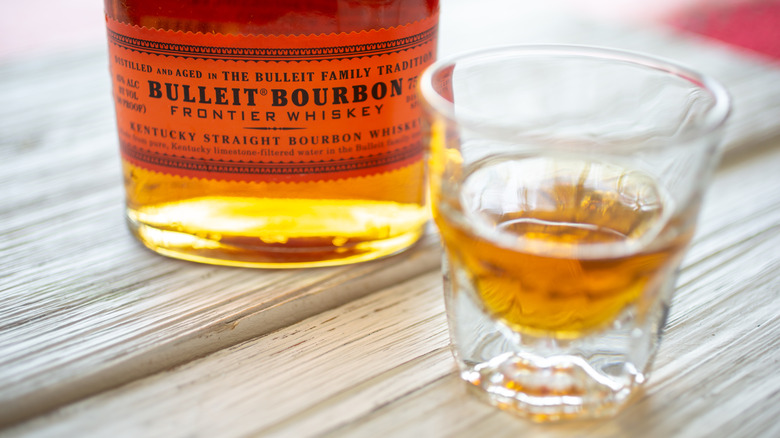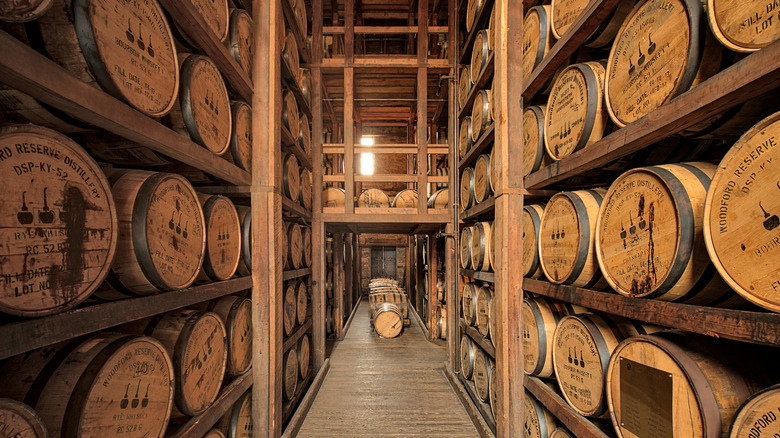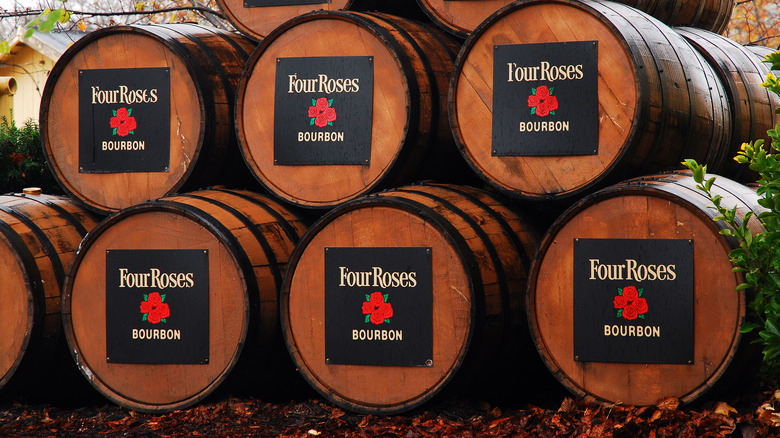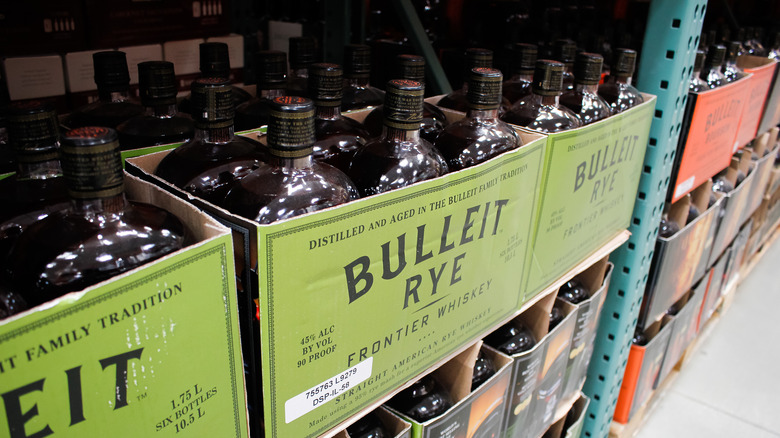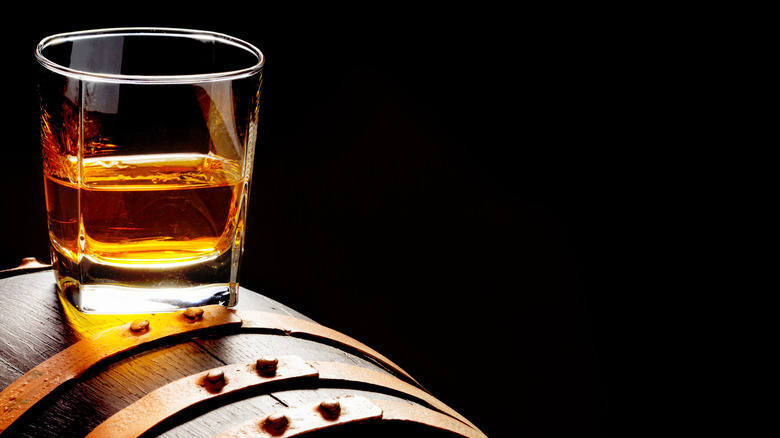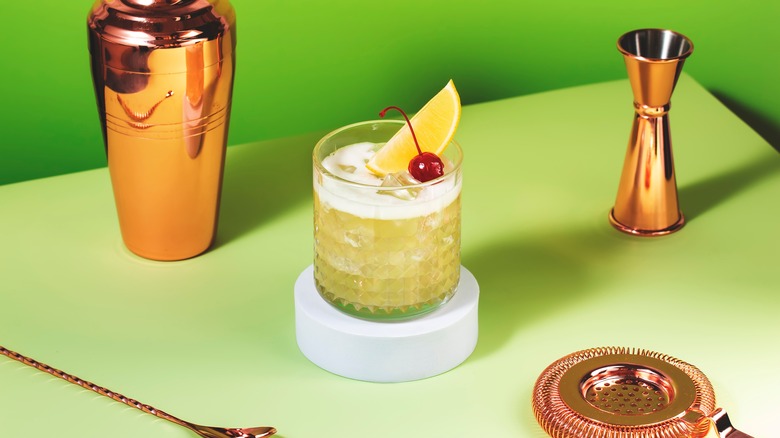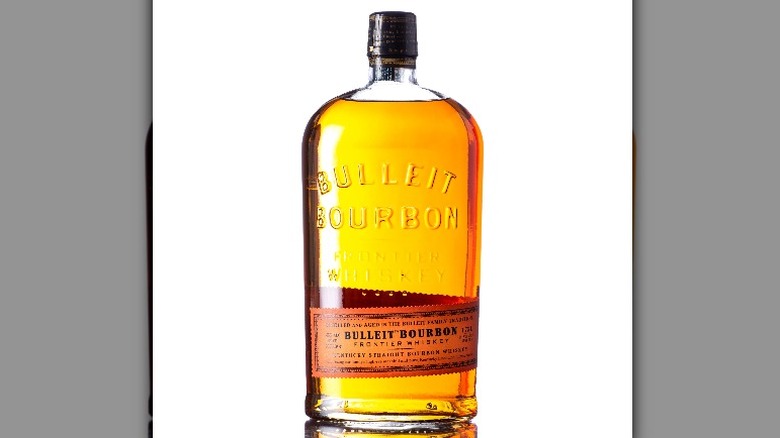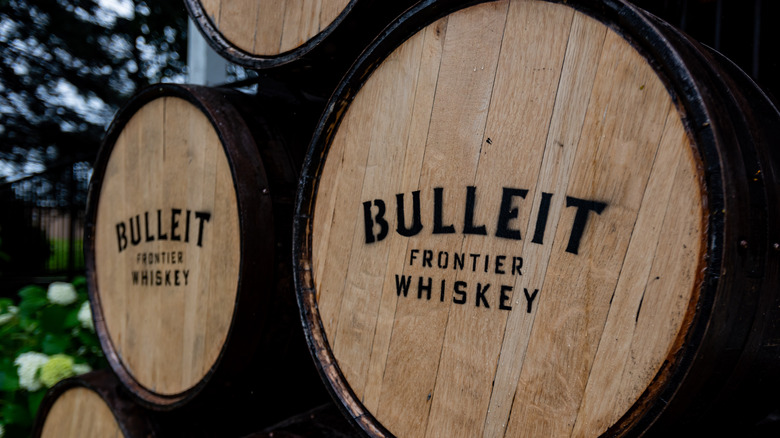What To Know Before Taking Another Sip Of Bulleit
You've most likely spotted Bulleit Bourbon from afar, given its distinctive, crooked orange label (there's a specific reason behind this, but you'll have to carry on reading to find out). According to Diageo, Bulleit reigns in the "top-selling" whiskey category across America, pioneering in the "rye-forward" department, ultimately leaving you with a bold, spicy flavor with notes of oak, nutmeg, and maple, buttoned up with a particularly dry and satin finish. You'll also take note of its alluring amber color. It's aged to perfection too. "Our aging philosophy is simple: We wait until our bourbon is ready," Bulleit asserts. The brand has seized countless awards, such as winning Gold at San Francisco World Spirits Competition. The credentials are apparent, and if you haven't sipped a glass of Bulleit yet, we're sure you'll be whisked away to a land of euphoria. However, before you take another sip, we'd like to arm you with everything you need to know about this iconic bourbon brand. Yep, this includes the ugly too.
Bulleit's original founder vanished
The Bulleit story starts back in Louisville Kentucky in 1830, a time when bourbon production was simmering and flavor experimentation was on the forefront (via Forbes Travel Guide). Tavern owner Augustus Bulleit worked endless hours to finetune his exploratory whiskey varieties, attempting to concoct a luxuriant blend that would stand out amongst the rest with just one sip. Eventually he honed in on a high-rye recipe in a league of its own. According to Forbes Travel Guide, Bulleit ended up setting sail to New Orleans alongside his coveted barrel in hopes of commercializing his product, but he completely vanished on that work trek. To this day, no one knows what happened to this unfortunate soul. Years later in 1987, Thomas E. Bulleit, Jr., decided to pick up the family torch again and revive his great-great-grandfather's exclusive recipe, continuing the "high-rye" mash bill. This is when Bulleit as we know it today kicked into high gear.
The distillery location was a mystery
For a long time, whiskey drinkers questioned the production location of Bulleit, as there were zero traces of it online, raising a bit of a frenzy. Many Bulleit connoisseurs inquired about where exactly Bulleit was distilled, aged, and bottled, and the brand's owner — global alcohol company Diageo – for many years remained a bit ambiguous on the subject. A lawsuit was eventually filed by two California Law Firms back in 2015, accusing the brand of violating California consumer protection laws over its labeling for Bulleit Bourbon. In a nutshell, the label was deemed as misleading, as the language claimed the production resided in Lawrenceburg, Kentucky. However, Diageo never operated a distillery in this vicinity. However, around a year after the lawsuit, Diageo announced major plans to invest $115 million in a Bulleit branded distillery in Shelby County, Kentucky, finally putting future speculation to bed. Now you can actually visit the distillery and experience firsthand the modern frontier of whiskey, through a variety of distillery tours and tastings.
Four Roses is closely affiliated
At one point in Bulleit's vast ownership history, it was a brand under the Seagrams empire, in which its "bourbon source" was allegedly Four Roses, according to Bourbonr Blog. That's right, the gorgeous bottle embossed with bright red roses was closely linked to Bulleit for over a decade. Even when the brand was acquired by Diageo, they chose to extend the contract with Four Roses, which supposedly was the supply for Bulleit until 2013. So what transpired after this? Well, Bulleit's sales skyrocketed and Four Roses couldn't keep up with ongoing demand (a problem Diageo surely wouldn't complain about). This ties back to the untold mystery behind Bulleit's production after 2013, until they established the Shelby County distillery. Many believe the "source" in that peculiar, liminal stage was simply an amalgamation of different distilleries. Some suspect Jim Beam or Barton, but we're unsure if the definitive truth will ever unfold.
Its history is rooted in scandal
This section contains allegations of discrimination based on sexual orientation, and of physical and sexual abuse.
In the span of just a few years, Bulleit faced scarring allegations amidst their booming sales and surge in popularity. According to Forbes, Bulleit's heiress, Tom Bulleit's daughter Hollis Worth, slammed Diageo, alleging that the brand owner fired her because she was lesbian. In a series of posts on Facebook and on her website, the heiress claimed that even though she dedicated two decades toward accelerating growth and bolstering marketing initiatives, she was often shunned by her family, even though many in the bourbon community looked to her as "The First Lady of Bourbon." Aside from this, Worth accused her estranged father, Tom Bulliet, of physical and sexual abuse until she was 18 years old. According to the Courier Journal, the 76-year-old Bulleit stepped down after these horrific claims emerged. Worth also publicly criticized Diageo for "backing a criminal." Outside of her accusations of abuse and workplace discrimination, Worth also claimed that she never received agreed upon royalties from her father and Diageo. There's no denying that these disastrous claims required an unthinkable amount of damage control for Bulleit.
If you or someone you know is dealing with domestic abuse, you can call the National Domestic Violence Hotline at 1−800−799−7233. You can also find more information, resources, and support at their website.
The rye content is uncharted
It's no secret by now that Bulleit's speciality is rye-forward bourbon — it's been that way since Augustus Bulleit started operations back in the 1800s (via Forbes Travel Guide). The mash bill is exactly 68% corn, 28% rye, 4% barley for their regular bourbon, leaving you with a spicier finish. Let's just say, if you're looking for a peppery bite, bourbon with high rye content is the best way to go. In fact, California bourbon drinkers (specifically in San Francisco) started to request rye-forward cocktails, which inspired Bulleit to release an award-winning, straight rye whiskey in 2011 — specifically catering to rye lovers. According to BlackTailNYC, this exceptional blend is made using 95% rye and 5% malted barley, leaving you with a bright and lively nose that's still subtly spicy, but sweeter than expected.
"I was blown away when I first tried this by how smooth, ultra sweet and fruity it is while still maintaining quite a spicy overtone. The fruity lingering finish of dried apricot, peaches, and even a hint of mango is truly sublime. Imagine this matured for a few more years and bottled at cask strength. Never thought a rye grain whiskey could be so good," said one Master of Malt reviewer.
Get ready for serious complexity
According to The Whiskey Shelf, Bulleit's innate character is slightly bold and spicy. There's a certain element of smoothness that's irresistible. Upon first whiff you'll detect a complex blend of fruitiness, including sour peach, baked apple, pineapple, and dried orange. After swirling, the citrus notes are accentuated, potentially transporting you to the tropical islands of Fiji. On the first sip, you'll arrive at another level of explosive flavor — notes of roasted vanilla, honey, baked apple, and licorice, along with some spices including clove, cinnamon, and fennel.
Based on the Beverage Tasting Institute, Chicago's review via The Whiskey Exchange, the medium-bodied palette is described as light, approachable, and refreshing, with a "sweet walnut fudge nose." This is a type of alcohol that warms you, exuding an elongated, velvety-smooth finish. So before taking one sip, get ready for something completely multidimensional — you'll certainly ignite all of the senses.
It dominates in the versatility arena
Due to Bulleit's remarkable range and deep complexity, it naturally dominates in the versatility department — meaning you can consume it in a variety of ways and still reap all of the tasty benefits. According to Liquor.com, you can drink Bulleit on the rocks, straight, or with a bit of water, club soda, or ginger ale. But don't fret, the land of consumption possibilities doesn't stop there. If you hop over to Bulleit's website, you'll find a plethora of colorful cocktail recipes to choose from, including a bartender's favorite, Bourbon Swizzle — a sweet and slightly sour concoction that incorporates bourbon, a swirl of citrus, spicy ginger, fresh mint leaves, and aromatic bitters. Perfectly refreshing on a warm spring afternoon on the porch if you ask us. Basically, the moral of the story is that you can't go wrong with your preferred method of drinking Bulleit, making it a must-have in your spirit cabinet.
The patented packaging is untouchable
If you're thinking about launching your own bourbon line soon, don't take design inspo from Bulleit — you might find yourself in a serious trademark infringement lawsuit, just like Redemption. That's right, Diageo fired back when Redemption released a bottle that closely mirrored the signature long and narrow cylinder-shaped Bulleit bottle, infringing upon the brand's image (per The Drink Business). This copycat bottle propelled Diageo to pursue destruction of infringing products and injunctive relief. Prior to this dispute, Bulleit also targeted Sazerac around the same issue, specifically around Dr. McGillicuddy's liqueur's new design that closely resembled Bulleit. But lucky for Bulleit, Sazerac agreed to pivot their design plans, and both parties reached an agreement outside the courtroom.
When it comes to packaging, it's also worth noting Bulleit's "intentional" crooked label. According to Men's Journal, back in the 1800s, any sort of label apparent on a bottle would've been wrapped and, of course, slightly warped. Now the crooked label is most definitely part of Bulleit's trademarked branding.
The price range is palatable for what you get
Since its inception, Bulleit's line has vastly expanded, with the brand offering a diverse array of bourbons to appeal to the masses. Good ole' Augustus Bulleit would likely be proud of all the progress. But if you're looking for a decent bottom shelf bourbon under $25, you should likely look elsewhere, because Bulleit is a heavy hitter in the mid-tier category.
According to Leaf TV, typically a mass produced bourbon (e.g. Jim Beam) should never land over the $25 mark. Premium bourbons usually range between $30-$60, depending on the mash bill, intricacies behind the aging process, and the overall craft. Every 750 ml Bulleit bottle ranges between $30-$60, as detailed by Luxe Digital. If you're looking for Bulleit Bourbon or Rye, you can anticipate spending around $30. On the pricier end, you'll find Bulleit Blenders' Select No. 001 Straight Bourbon Whiskey — which incorporates over 100 different liquids and is aged 9 or more years, per Caskers — at a price point of $59.99. Regardless of the expression you choose, you won't completely break the bank when it comes to purchasing Bulleit.
Bulleit has a venture to support bartenders and restaurants
With the launch of the Bulleit Frontier Fund, a $250,000 mighty money pot to keep the hospitality industry running like a well-oiled machine, bartenders across the country are pouring Bulleit like its exotic liquid gold. According to Vegas Magazine, this newly organized foundation holds a mission to keep restaurants and bartenders afloat, specifically during the global COVID-19 pandemic and throughout the waves of shutdowns. Not only does Bulleit constantly donate from a monetary perspective, but they've also released a strategic educational platform to keep bartenders' skills sharpened with at-home cocktail-making classes and industry insights, tagged under the specific hashtag #BulleitBarSkills. Bulleit is also committed to hiring real bartenders for content creation and commercials, opening up new money-making gateways for those professionals. Aside from this, Bulleit is also a partner of Sourced Craft Cocktails, which employs bartenders to make cocktails for home delivery. It's a creative and clever way to give back to the hospitality industry, while also incentivizing bartenders across America to keep pouring Bulleit through a tumultuous moment in history.
